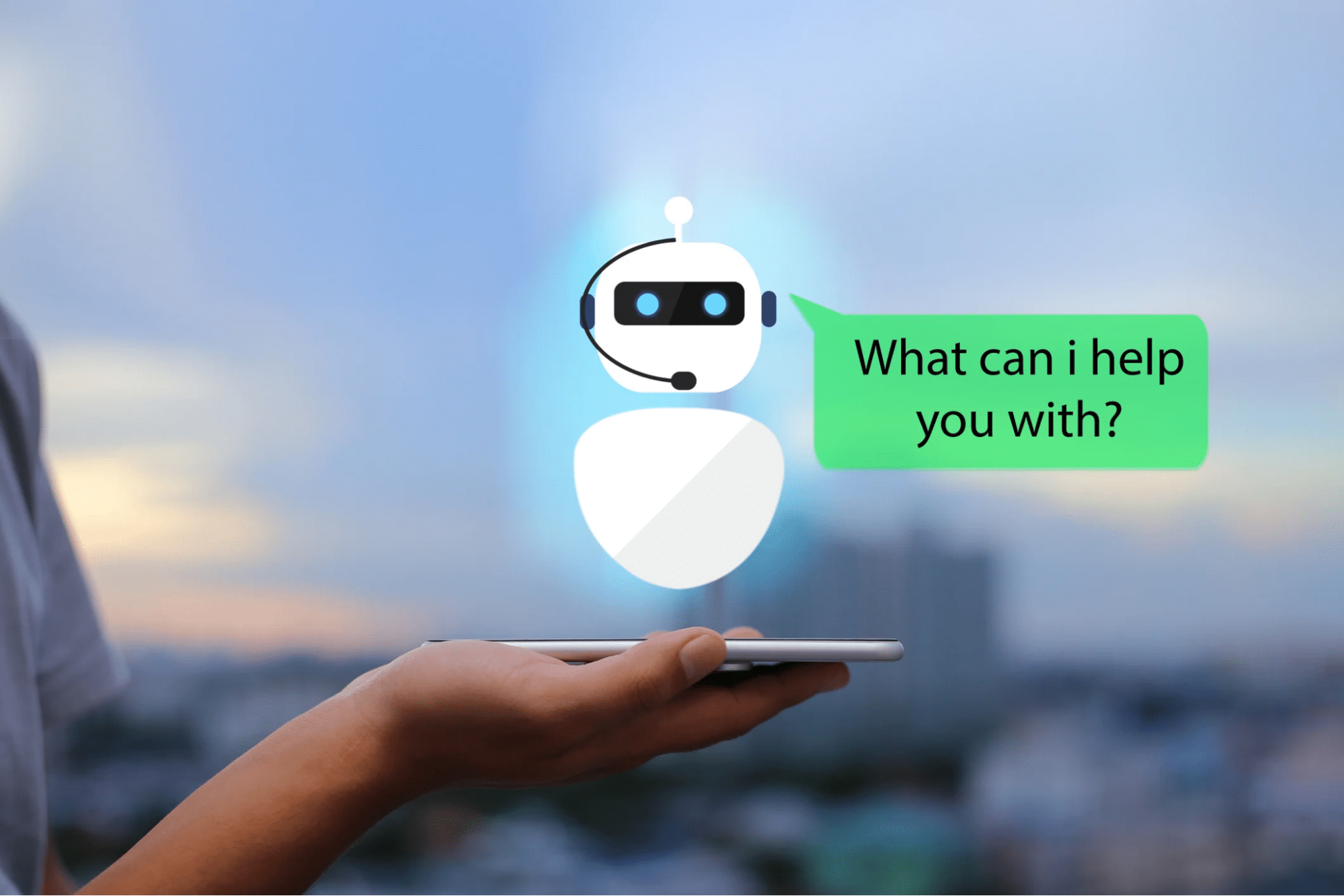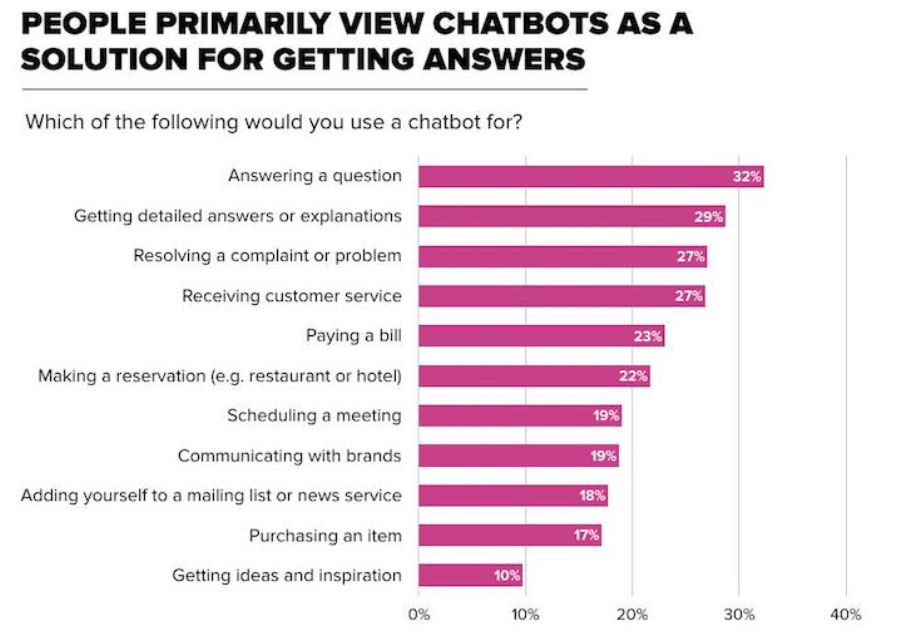53% of the world’s service organizations already use chatbots. Is your business one of them? It might be time to jump on the bandwagon if you haven’t already because chatbots are a trend that look set to stay. With article intelligence and machine learning evolving every day, chatbots have come a long way since the days of A.L.I.C.E and Clever Bot.
With automation at the core of most business chatbots, it’s easy to see why so many companies are implementing them into their marketing strategy. Enabling companies to automate manual tasks such as data entry and filing as well as handle customer requests around the clock, chatbots free up time for your team to concentrate on what’s most important.
The great thing about chatbots is that they can be customized to suit any industry. Whether you’re in retail, ecommerce, or SaaS, you’ll always be able to find a chatbot that fits your needs.
Before we dig any deeper, let’s go over the basics.
What are chatbots?
Simply put, AI chatbots are programs designed to help humans interact with computers. Ranging from the simple to the complex, chatbots can be designed to respond to messages the same way or produce tailored responses based on certain keywords (you can even program a chatbot to adapt its response over time with machine learning).
Businesses use chatbots over various messaging platforms like Facebook, SMS, and website chat portals to simplify customer service interactions and ensure there is 24/7 support available. Chatbots can also be used as a form of SAP automation, helping businesses automate manual repetitive tasks so teams can concentrate on more important tasks.
Chatbots can even be used as part of your digital marketing strategy – they can easily collect data and customer information for sales calls and help inform your business of where changes could be made to improve the customer experience.
Here’s why you should think about using chatbots in your business
If you’re still unsure about the benefits chatbots can bring to your business, here’s some food for thought:
1. Chatbots help optimize the customer journey with 24/7 support
The great thing about chatbots is that they can be used around the clock to provide support to customers, even once your business is officially closed for the day. This is probably one of the most popular use cases of chatbots for businesses; they provide swift responses to customers at any hour of the day.
These quick response times, coupled with the fact that users are able to reach out to you on their own terms, will increase satisfaction levels and make for a better customer experience.
Not all customers will want to contact an agent over the phone, so having a chatbot will also make sure you cater for all customer requests. Happy customers = loyal and repeat buyers, and chatbots are an easy way of bumping up that conversion rate.
2. Chatbots are cost and time effective
Since chatbots can take on the role of customer service agent, your actual team can spend more time focusing on what’s most important: driving sales and building relationships with clients. There’s no reason your employees should spend time on manual repetitive work admin tasks when they could be allocating that time to something that will drive revenue for your business.
Automating certain interactions with customers can also help save money in the long-run since you’ll cut down on the resources needed to get a live agent into the conversation.
3. Chatbots help in lead generation
You might not have thought it, but a computer can actually help bring in more quality leads. Since chatbots can easily collect and analyze data given by customers over FAQ or chat portals, they’ll be able to sift through customer responses and gather the information needed to provide great customer service.
This means chatbots will be able to get information out of customers without a human needing to intervene. Not only does this save a live agent’s time from answering repetitive questions – the chatbot will also be able to deliver viable leads to the sales team efficiently.
The best chatbot examples to implement
Before you consider the many chatbots out there, you’ll have to figure out how you’ll actually design your own chatbot. You could get a cloud solutions architect in to help build your bot or you could visit a platform that specializes in creating chatbots.
Most of these platforms will have an open API, meaning you’ll be able to customize your chatbot to suit your business needs. If you’re a whiz at tech, you could even try creating your own chatbot from scratch (but beware – there’s lots of code involved).
Each avenue will incur some kind of cost, so it might be a good idea to check out the pricing behind each and see if it fits into your budget. You’ll also want to consider the amount of time it takes to get your bot up and running, and in most cases bringing a specialist in will speed things along.
Now that you know how to create your chatbot, we’ve compiled a list of the best chatbot examples for you to get inspired by.
1. Survey chatbot
Key to getting essential information from your customers, surveys can help give you a better understanding of how your target audience views your brand and what you could be doing better. But what is the best way of actually engaging customers and getting them to fill in your survey?
They’re already bombarded with requests on a daily basis from work, so why should they take the time to fill out your survey? This is especially true in the case of email or phone surveys – a lot of your customers won’t want to waste time opening an email and reading through a boring script and talking to a live agent.
Your best bet is with a survey chatbot; this way, your customers will be met with a simple and quick survey that’s easy to fill out, plus you’ll be able to make sure it’s optimized for mobile.
2. FAQ chatbot
For those times when your customer service team isn’t around, implementing an FAQ chatbot is a great way of providing support to customers when they need it most. Since FAQs are simple and generally stay the same, a chatbot function can be used to mimic the act of talking to a live agent.
Not only does this ensure that your business is able to answer questions 24/7, but it also makes for a better user experience. Customers are much more likely to return and become repeat buyers once they know their queries will be responded to promptly.
Having an FAQ chatbot will also go a long way to helping your live agents as it frees up time for them to concentrate on the more complex calls with customers. Since a chatbot will help customers navigate answers to the most commonly asked questions, it will reduce the amount of people contacting your live agents for repetitive information.
It’s simple: when you embrace automation, you cut out time wasted on manual, repetitive tasks.
3. Website chatbot
One of the easiest ways to grab your customer’s attention and engage them is through a website chatbot. Simply another form of live chat, website bots are usually designed to create a guided experience, equipping the user with useful information and referrals.
The majority of website live chats are designed on either the homepage or landing page; this way, customers are met with important information as soon as they land on your site. The whole point of a website chatbot is to be user-focused, so concentrate on friendly ice-breaker messages, referrals to specific departments, or links to specific product pages depending on the customer’s needs.
If you’re worried about setting up your website chatbot or simply don’t have enough time, there are lots of tutorials to help guide you through the design process. If all else fails, you can use a chatbot platform to help you get there without any problems.
4. Social media chatbot
If you thought chatbots were limited to your website, think again. More and more customers are interacting with brands via social media, so it only makes sense to implement chats across your various socials, especially if you have a lot of subscribers. Some of the most popular places to deploy chatbots include:
- Facebook messenger
There are more than 300,000 active chatbots on Facebook messenger – and for good reason. Aside from providing customers with a self-service option to answering their queries, a Facebook messenger bot collects and analyzes data during customer interactions – giving businesses the inside line on what consumers are looking for.
One of the most popular use cases for a Facebook chatbot is to book appointments, answer FAQs, and provide simple information on services offered – all you need is a Facebook page and a few followers to start.
Instagram has grown in popularity for many businesses over the last few years for its ability to interact and engage with customers directly, while acting as a marketing platform. Similar to Facebook, Instagram bots can be used as a form of live chat and interaction with customers, answering simple queries, and enabling customers to come to you at any time of the day.
- Whatsapp, Telegram, and Kik messaging apps
Not just messaging apps, Whatsapp, Telegram, and Kik are starting to be used by more and more businesses as a customer service portal. Simply include a phone number for customers to message, and let the bot answer the most frequently asked questions so your team doesn’t have to.
Whatsapp chatbots can also be optimized to send regular notifications to customers, and since queries are getting answered promptly, you’ll develop a sense of brand loyalty and trust.
And remember – your live chat bots don’t have to be stale and boring. Just because they’re automated and designed to answer in a specific way doesn’t mean you can’t inject a bit of fun into them (after all, it makes them a little more human).
Use emojis and gifs in chatbot conversation to spice things up and think about personalizing your chatbot’s tone of voice to sound a little more human and a little less robotic. Avoid copying text from templates and try to come up with a more original voice for your chatbot that really speaks to your customers.
5. Scheduling chatbot
Make your customer’s lives easier by giving them the power to book and schedule appointments and meetings with you. Acting as a sort of virtual assistant, a lot of customers prefer this kind of self-service navigation (67%, to be exact) since it cuts out time spent waiting on the line to connect with a live agent.
This kind of self-service also means your team can quit focusing on scheduling and manual admin tasks, and put their time to more useful projects that drive revenue. A perfect example of a scheduling chatbot is Babylon, a healthcare platform. Users can easily schedule and book appointments with doctors using a chatbot that offers personalized consultations based on medical history.
Your business doesn’t need to be in the healthcare sector to make use of a scheduling bot, though – if you’re regularly taking appointments or holding a live event such as a seminar or web meeting, then it might be a good idea to get a chatbot involved in the process.
6. Call center chatbot
If you have a call center, one of your biggest goals is to have as quick a response time as possible – but what happens once your customer support team goes home for the day? What if a customer needs to contact you out of hours? The solution – call center chatbots!
Answering simple FAQs in real-time, call center chatbots are able to understand human speech through the help of natural language processing – meaning they don’t need to rely on specific phrases or buzzwords to continue the conversation. This enables customers to have easy access to real-time support around the clock, making for a better customer experience and increasing their satisfaction levels.
Not only will it strengthen the relationship you have with customers, it will also minimize the chances of agents encountering repetitive questions that could be answered by a simple bot. Call center chatbots essentially double as a form of workflow software, helping to streamline your business operations so your team can focus on the most important tasks.
The majority of VoIP service providers offer some kind of chatbot to help optimize your call center, so have a look around until you find one that’s right for your business.
7. Lead generation chatbot
Chatbots are great at collecting and analyzing data from customer interactions, providing your business with key customer insight to shape certain strategies and approaches, as well as qualify viable leads.
The real estate industry is a good example of a space that could benefit from a lead generation chatbot, as agents often have to deal with hundreds of listings and customer preferences. Chatbots make this process simpler, interacting with customers before the agent does to collect key information on their dream property.
This information is then fed into the system so property recommendations can be made, as well helping to notify the agent of what the customer really wants – all making it easier to deliver to their expectations.
8. Personalized recommendations chatbot
Using a chatbot is a great way of simplifying the customer journey if you have a lot of products or services on offer. Instead of making the customer sift through tens upon tens of pages, use a chatbot that personalizes product recommendations and directs your customers to the specific things they want.
Sephora is a great example of a business leveraging chatbots to provide personalized recommendations and engagement to customers. Users are guided to a quiz that helps the chatbot analyze which products the customer is interested in, helping them quickly find what they’re looking for.
Tutorials and makeup lessons are also part of Sephora’s chatbot strategy – a great way of staying connected to customers and adding that human touch.
Takeaway
It’s clear chat bots aren’t just a passing fancy; they’re set to stay and revolutionize the way we do business. It’s only within the past five years that they’ve exploded onto the professional sphere anyway, so now truly is the best time to jump on the scene.
While chatbots and AI are key to maximizing your businesses’ efficiency and engaging customers, human connection and empathy will still always be popular. That added human touch from a business is something customers really crave in today’s digital world, so be sure to hit a balance and make your chatbots as friendly and human as possible, as well as providing a bit of real-life support from live agents.










